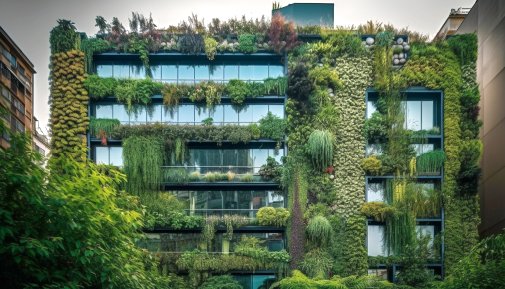By Heba Nazer, Green Buildings & Sustainability Expert
Trees are the earth’s quiet guardians, as they absorb carbon dioxide, filter pollutants and breathe life into the air.
While planting more trees is often seen as a simple solution to climate change, their role goes far beyond environmental symbolism. Trees are natural climate regulators, influencing the temperature and comfort of the spaces we occupy in ways we may not always notice.
Nature’s Regulators
Trees are nature’s most efficient regulators, absorbing carbon dioxide and releasing the oxygen we breathe. They act as the planet’s natural carbon sinks, by storing vast amounts of carbo dioxide. This is mostly evident in the Amazon Rainforest, often referred to as the Lungs of the Earth, producing 20 per cent of the world’s oxygen and stabilising global weather patterns.
Beyond the Amazon, forests worldwide play a crucial role in balancing ecosystems, cooling cities and preventing soil erosion.
Yet, as deforestation accelerates, this balance is under threat—making the protection and restoration of trees more urgent than ever.
In regions like Jordan, where just around one per cent of the land is covered by trees, the importance of integrating green spaces into urban environments is even more critical. In addition to their aesthetical purpose around buildings, trees contribute to energy efficiency and reduced energy costs in heating and cooling through shading, ventilation, cooling and wind control.
Trees and Energy Efficiency
In densely populated urban areas, where concrete and steel dominate, trees help cool the environment and provide shade, reducing the need for energy-intensive air conditioning indoors.
Here are some of the key benefits that trees and vegetation bring to urban spaces:
1. Natural Cooling of Buildings
Natural cooling means lowering indoor temperatures while reducing energy consumption and cost. A common design mistake is the improper positioning of windows limiting the entry of cool air and increasing heat.
However, by using trees around windows, you can can block direct sunlight and cool the surrounding air while reducing temperatures.
As the air near the windows cools, it becomes denser and naturally flows indoors replacing warmer air and effectively lowering indoor temperatures.
This approach enhances energy efficiency by minimising the need for mechanical cooling and provides a sustainable solution for maintaining comfort in warmer climates.
2. Nature’s Air Conditioner
Trees absorb water through their roots and release it as water vapour through their leaves. This process cools the surrounding air, reducing the temperature by around five degrees centigrade.
This is especially important in cities, where buildings and roads trap heat and make the area hotter than the countryside
Planting trees in the city can lower energy use by up to 30 per cent, saving money and keeping homes cooler during hot weather
3. Wind Breakers
Trees serve as powerful windbreakers in the winter, helping to lower energy consumption and increase comfort inside buildings.
Trees planted in the most prevailing wind direction will act as natural shields, reducing the impact of cold winds and minimising heat loss.
Windbreakers can reduce wind speed by around 85 per cent, with the height of the trees being the most crucial factor in their effectiveness. The taller the trees, the larger the area they protect, extending their benefit to the entire building.
By controlling wind speed, windbreakers help prevent pressure differences around buildings, keeping warm air inside and cold air out.
To achieve optimal protection, windbreakers should be planted at a distance of about two to five times the height of the trees when they reach maturity. This ensures that the trees provide sufficient coverage without blocking sunlight, especially on south-facing walls during peak daylight hours.
4. Shading
One of the most effective ways trees impact energy efficiency is through shading. By placing trees around buildings, especially on south-facing facades, they block out harsh summer sunlight, reducing the amount of solar radiation absorbed by the building.
Deciduous trees can block up to 85 per cent of the sun’s radiation in summer, reducing the energy consumption from air conditioning.
While in winter, when the leaves fall, trees allow up to 70 per cent of solar radiation to enter the building, helping to naturally warm it.
This simple strategy can drastically cut energy consumption in both summer and winter, maintaining a comfortable indoor temperature year-round.
Planting shorter trees and shrubs near a building and taller trees further away helps shade the south side in summer, which gets the most sun.
In Amman, east and west sides without shade can raise indoor temperatures by up to two degrees Celsius in summer
Vertical Gardens and Green Roofs
In areas where ground space is limited, vertical gardens (also known as green walls) and green roofs offer innovative solutions to integrate greenery into the built environment.
Vertical gardens are structures covered with plants that grow vertically on building facades or interior walls, using soil, hydroponic systems, or other growing mediums to sustain plant life.
These gardens maximize green space, reduce heat absorption and improve air quality, leading to lower indoor temperatures and reduced energy consumption.
Psychologically, green walls promote relaxation, reduce stress and enhance wellbeing by creating a connection to nature.
They also contribute to better indoor air quality, support biodiversity and provide a healthier and more comfortable environment for occupants.
A green roof is a specialised rooftop garden that is partially or fully covered with plants, along with a carefully designed infrastructure and growing medium.
Green roofs contribute in the conservation of both cooling and heating energy; promoting biodiversity aesthetics and health benefits.
Green roofs can also serve as an ideal solution for planting when traditional garden space is limited.
Studies indicate that green roofs can reduce heating and cooling by up to 17 per cent .
Green roofs can be installed on a wide range of buildings, from industrial facilities to private residences.
Types of green roofs
There are two types of green roofs: extensive and intensive; extensive green roofs have shallow soil less than 15 centimetres with low-maintenance vegetation.
Intensive green roofs have deeper soil more than 15 centimetres and support diverse, high-maintenance plantings like gardens and trees.
In densely populated cities, the urban heat island effect is a major contributor to increased energy use. Urban heat island occurs when cities become significantly hotter than surrounding rural areas due to human activity and the large concentration of heat-retaining surfaces like asphalt, concrete and metal.
Earth Day – A Global Call to Action
Earth Day is a perfect reminder of the collective responsibility we have to protect and nurture our planet. Celebrated annually on 22 April, it’s a day dedicated to raising awareness about environmental issues and taking action to create a more sustainable future.
Whether it’s planting a tree, reducing waste, or committing to more sustainable lifestyle choices, Earth Day is a reminder that every small effort matters.
Planting a tree on Earth Day can be a symbolic gesture of commitment to a greener planet and an impactful way for families to engage in environmental stewardship while fostering a sense of responsibility in younger generations
You can contact Heba Nazer at [email protected]






